DC Aging Mechanism of Co2O3-Doped ZnO Varistors †
Abstract
:1. Introduction
2. Experiment
3. Results and Discussion
3.1. Macro Electrical Properties
3.2. Dielectric Response
3.3. Discussion
4. Conclusions
Author Contributions
Funding
Data Availability Statement
Conflicts of Interest
References
- He, J.L. Metal Oxide Varistors; TsingHua University Press: Beijing, China, 2019; pp. 1–4. [Google Scholar]
- Kaufmann, B.; Billovits, T.; Kratzer, M.; Teichert, C.; Supancic, P. A modelling approach to describe the DC current-voltage behaviour of low-voltage zinc oxide varistors. Open Ceram. 2021, 6, 100113. [Google Scholar] [CrossRef]
- Tsovilis, T.E.; Topcagic, Z. DC Overload Behavior of Low-Voltage Varistor-Based Surge Protective Devices. IEEE Trans. Power Deliv. 2020, 35, 2541–2543. [Google Scholar] [CrossRef]
- Blatter, G.; Greuter, F. Carrier transport through grain boundaries in semiconductors. Phys. Rev. B 1986, 33, 3952–3966. [Google Scholar] [CrossRef] [PubMed]
- Blatter, G.; Greuter, F. Electrical breakdown at semiconductor grain boundaries. Phys. Rev. B 1986, 34, 8555–8572. [Google Scholar] [CrossRef]
- Gupta, T.K. Application of Zinc Oxide Varistors. J. Am. Ceram. Soc. 1990, 73, 1817–1840. [Google Scholar] [CrossRef]
- Gupta, T.K.; Carlson, W.G. A grain-boundary defect model for instability/stability of a ZnO varistor. J. Mater. Sci. 1985, 20, 3487–3500. [Google Scholar] [CrossRef]
- Eda, K.; Iga, A.; Matsuoka, M. Degradation mechanism of non-ohmic zinc oxide ceramics. J. Appl. Phys. 1980, 51, 2678–2684. [Google Scholar] [CrossRef]
- Gupta, T.K.; Carlson, W.G. Barrier voltage and its effect on stability of ZnO varistor. J. Appl. Phys. 1982, 53, 7401–7409. [Google Scholar] [CrossRef]
- Ramanachalam, M.S.; Rohatgi, A.; Schaffer, J.P.; Gupta, T.K. Characterization of ZnO varistor degradation using lifetime positron-annihilation spectroscopy. J. Appl. Phys. 1991, 69, 8380–8386. [Google Scholar] [CrossRef] [Green Version]
- Yang, P.; Gomez, C.A.; Andrews, S.; Sorenson, J.D.; Chen, K.S. High-voltage surge protection by a varistor-filled air gap. J. Am. Ceram. Soc. 2021, 104, 3247–3259. [Google Scholar] [CrossRef]
- Ohbuchi, Y.; Kawahara, T.; Okamoto, Y.; Morimoto, J. Characterization of interface states in degraded ZnO varistors. Jpn. J. Appl. Phys. 2002, 41, 190–196. [Google Scholar] [CrossRef]
- Takahashi, K.; Miyoshi, T.; Maeda, K. Degradation of Zinc Oxide Varistors. MRS Proc. 1981, 5, 399. [Google Scholar] [CrossRef]
- Ramirez, M.A.; Simoes, A.Z.; Bueno, P.R.; Márquez, M.A.; Orlandi, M.O.; Varela, J.A. Importance of oxygen atmosphere to recover the ZnO-based varistors properties. J. Mater. Sci. 2006, 41, 6221–6227. [Google Scholar] [CrossRef]
- Mielcarek, W.; Gubanski, A.; Paściak, G.; Prociów, K.; Warycha, J.; Wrobel, J.M. The effect of bismuth oxide polymorph forms on degradation processes in ZnO varistors. Ceram. Int. 2013, 39, 8219–8226. [Google Scholar] [CrossRef]
- Anderson, R.S. Lattice-vibration effects in the spectra of ZnO:Ni and ZnO:Co. Phys. Rev. 1967, 164, 398–405. [Google Scholar] [CrossRef]
- Kim, E.D.; Kim, C.H.; Oh, M.H. Role and effect of Co2O3 additive on the upturn characteristics of ZnO varistors. J. Appl. Phys. 1985, 58, 3231–3235. [Google Scholar] [CrossRef]
- Yano, Y.; Takai, Y.; Morooka, H. Interface states in ZnO varistor with Mn, Co and Cu impurities. J. Mater. Res. 1994, 9, 112–118. [Google Scholar] [CrossRef]
- Guo, M.; Wang, Y.; Wu, K.N.; Zhang, L.; Zhao, X.; Lin, Y.; Li, J.Y. Revisiting the effects of Co2O3 on multiscale defect structures and relevant electrical properties in ZnO varistors. High Volt. 2020, 5, 241–248. [Google Scholar] [CrossRef]
- Shuk, P.; Wiemhofer, H.D.; Guth, U.; Göpel, W.; Greenblatt, M. Oxide ion conducting solid electrolytes based on Bi2O3. Solid State Ion. 1996, 89, 179–196. [Google Scholar] [CrossRef]
- Tanaka, T.; Baba, Y.; Tsujimoto, Y.; Tsukamoto, N. FDTD Electromagnetic and Thermal Simulation of a Metal Oxide Varistor Element Considering the Temperature Dependence of Its Resistivity. Electricity 2021, 2, 158–167. [Google Scholar] [CrossRef]
- Staikos, E.T.; Tsovilis, T.E. Low-frequency response of low-voltage metal-oxide varistors used for telecommunication systems protection. In Proceedings of the 2020 IEEE International Conference on High Voltage Engineering and Application (ICHVE), Beijing, China, 6–10 September 2020; pp. 1–4. [Google Scholar]
- Huang, Y.; Wu, K.; Xing, Z.; Zhang, C.; Hu, X.; Guo, P.; Li, J.Y. Understanding the validity of impedance and modulus spectroscopy on exploring electrical heterogeneity in dielectric ceramics. J. Appl. Phys. 2019, 125, 084103. [Google Scholar] [CrossRef]
- Zhao, X.; Shi, W.D.; Zhang, B.Y.; Guo, M.; Shen, H.B. Relaxation peaks of ZnO varistors and their correlations with electrical properties. Jpn. J. Appl. Phys. 2021, 60, 031006. [Google Scholar] [CrossRef]
- Cole, K.S.; Cole, R.H. Dispersion and absorption in dielectrics I. alternating current characteristics. J. Chem. Phys. 1941, 9, 341–351. [Google Scholar] [CrossRef] [Green Version]
- Cheng, P.; Li, S.; Zhang, L.; Li, J.Y. Characterization of intrinsic donor defects in ZnO ceramics by dielectric spectroscopy. Appl. Phys. Lett. 2008, 93, 012902. [Google Scholar] [CrossRef]
- Zhao, X.; Li, J.Y.; Li, H.; Li, S.T. Intrinsic and extrinsic defect relaxation behavior of ZnO ceramics. J. Appl. Phys. 2012, 111, 6132. [Google Scholar] [CrossRef]
- West, A.R.; Andres-Verges, M. Impedance and Modulus Spectroscopy of ZnO Varistors. J. Electroceramics 1997, 1, 125–132. [Google Scholar] [CrossRef]
- Huang, Y.; Wu, K.; Tang, Z.; Xin, L.; Zhang, L.; Li, J. Investigation of electrical inhomogeneity in ZnO varistor ceramics based on electronic relaxations. Ceram. Int. 2019, 45, 1110–1114. [Google Scholar] [CrossRef]
- He, J.; Li, S.; Lin, J.; Zhang, L.; Feng, K.; Zhang, L.; Li, J. Reverse manipulation of intrinsic point defects in ZnO-based varistor ceramics through Zr-stabilized high ionic conducting βIII-Bi2O3 intergranular phase. J. Eur. Ceram. Soc. 2018, 38, 1614–1620. [Google Scholar] [CrossRef]
- Janotti, A.; Van de Walle, C.G. Fundamentals of zinc oxide as a semiconductor. Rep. Prog. Phys. 2009, 72, 126501. [Google Scholar] [CrossRef] [Green Version]
- Stucki, F.; Greuter, F. Key role of oxygen at zinc oxide varistor grain boundaries. Appl. Phys. Lett. 1990, 57, 446–448. [Google Scholar] [CrossRef]
- Bueno, P.R.; Leite, E.R.; Oliveira, M.M.; Orlandi, M.O.; Longo, E. Role of oxygen at the grain boundary of metal oxide varistors: A potential barrier formation mechanism. Appl. Phys. Lett. 2001, 79, 48–50. [Google Scholar] [CrossRef]
- Eda, K. Zinc oxide varistors. IEEE Electr. Insul. Mag. 1989, 5, 28–30. [Google Scholar] [CrossRef]
- Emtage, P.R. The physics of zinc oxide varistors. J. Appl. Phys. 1977, 48, 4372–4384. [Google Scholar] [CrossRef]
- Chiang, Y.; Kingery, W.D.; Levinson, L.M. Compositional changes adjacent to grain boundaries during electrical degradation of a ZnO varistor. J. Appl. Phys. 1982, 53, 1765–1768. [Google Scholar] [CrossRef]
- Topcagic, Z.; Tsovilis, T.E. Varistor Electrical Properties: Microstructural Effects. In Encyclopedia of Materials: Technical Ceramics and Glasses; Pomeroy, E.M., Ed.; Elsevier: Oxford, UK, 2021; pp. 254–271. [Google Scholar]
- Zhou, Q.; Yang, H.; Huang, X.; Wang, M.; Ren, X. Numerical modelling of MOV with Voronoi network and finite element method. IET High Volt. 2021, 1–8. [Google Scholar] [CrossRef]
- Greuter, F. ZnO Varistors: From Grain Boundaries to Power Applications. In Oxide Electronics; Wiley: Hoboken, NJ, USA, 2021. [Google Scholar]
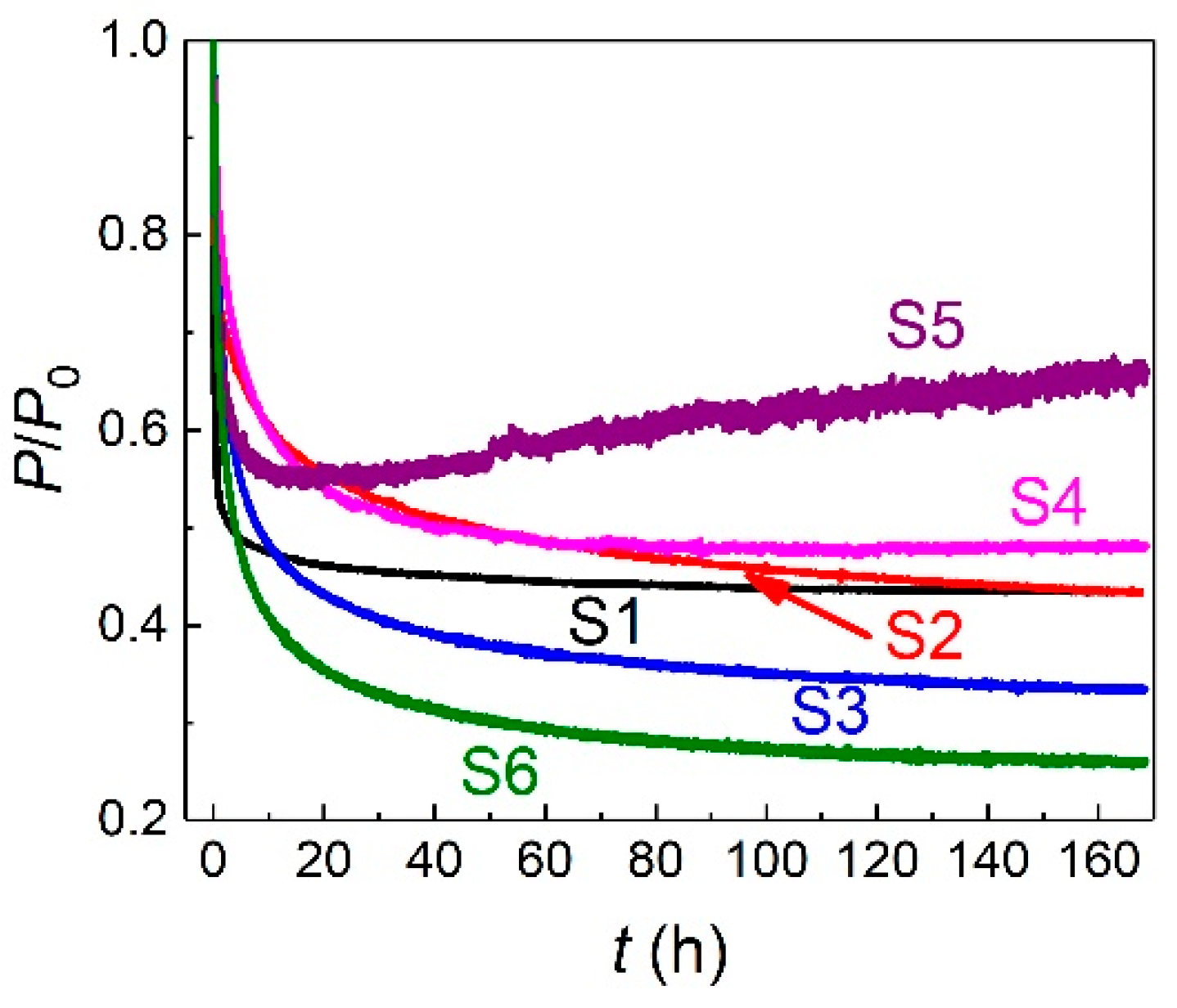
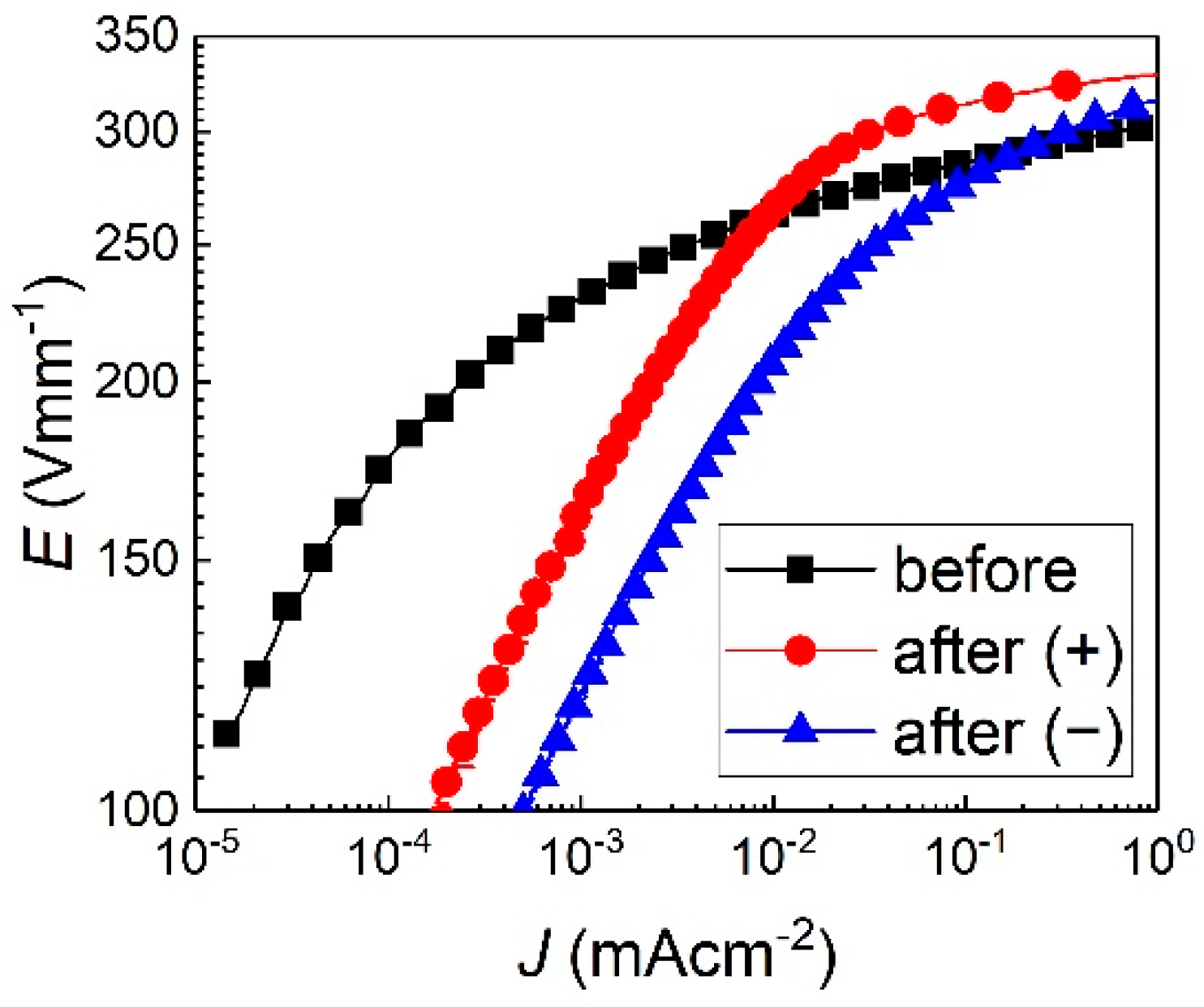

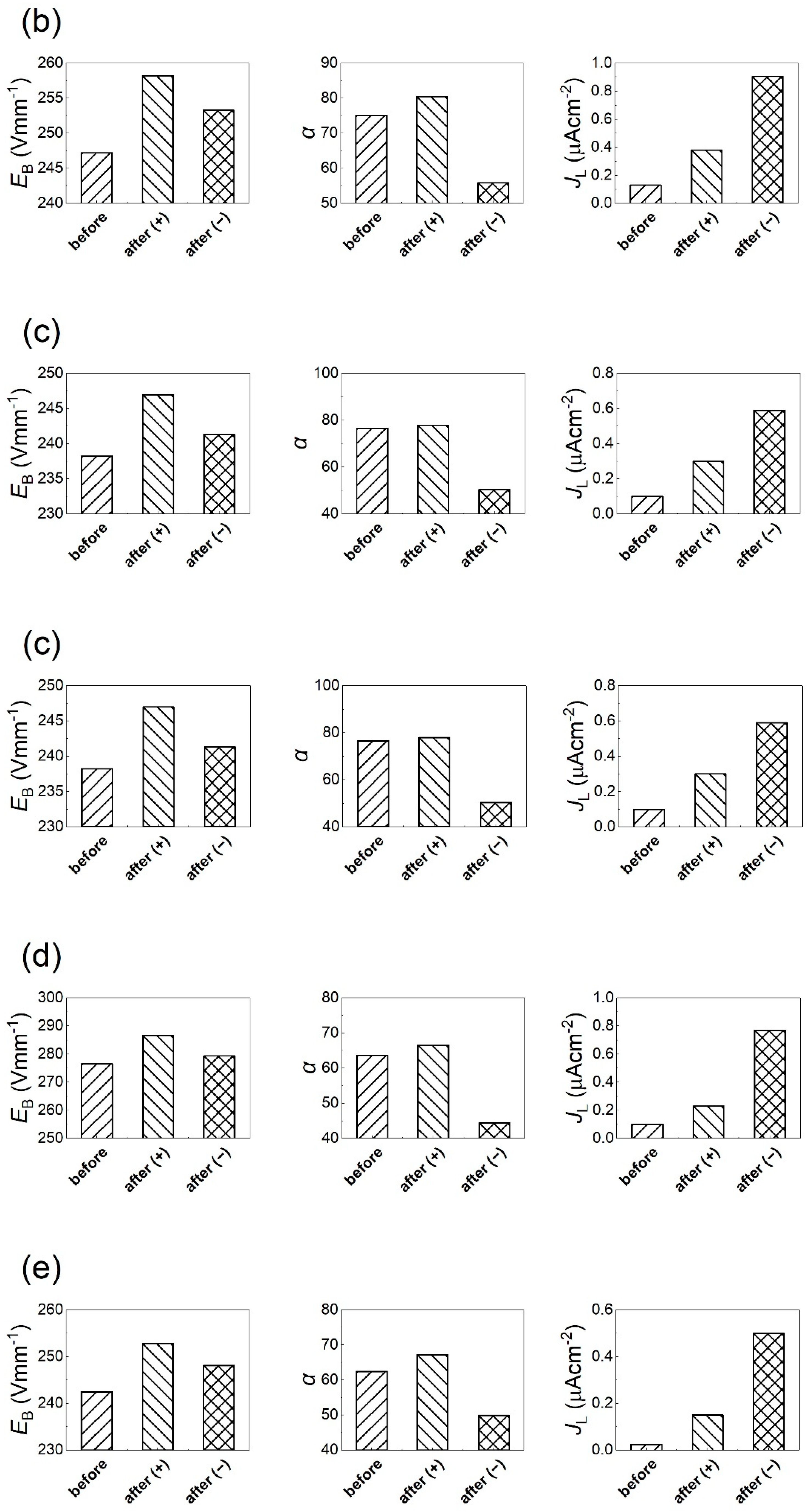
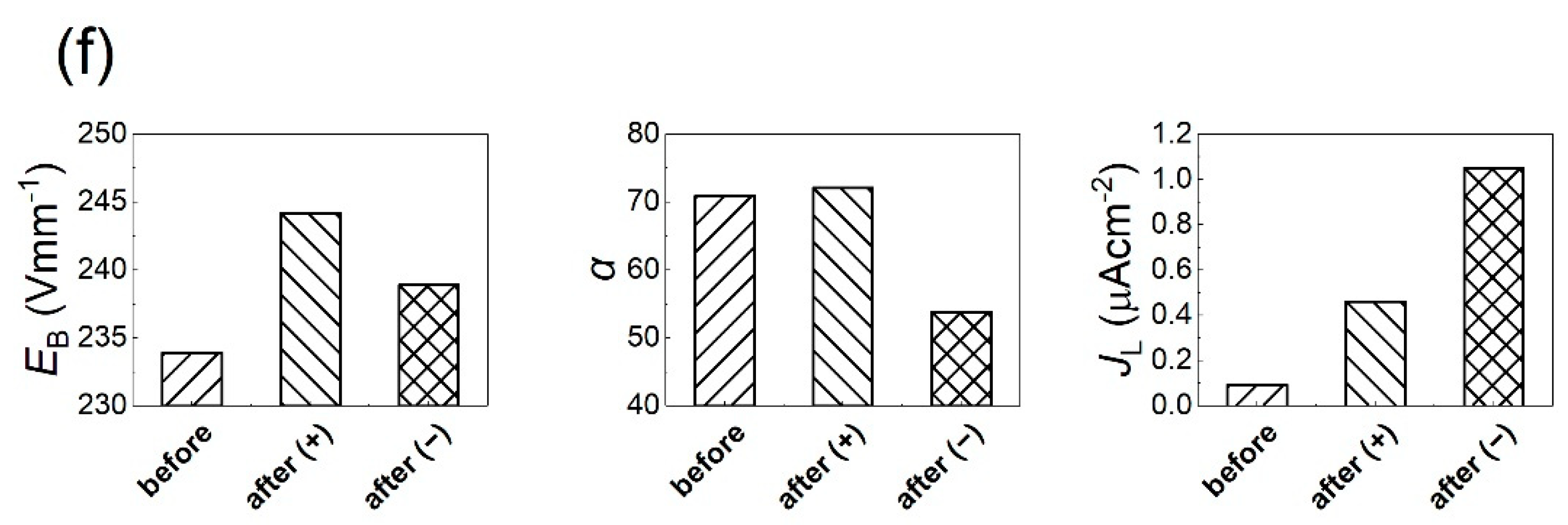
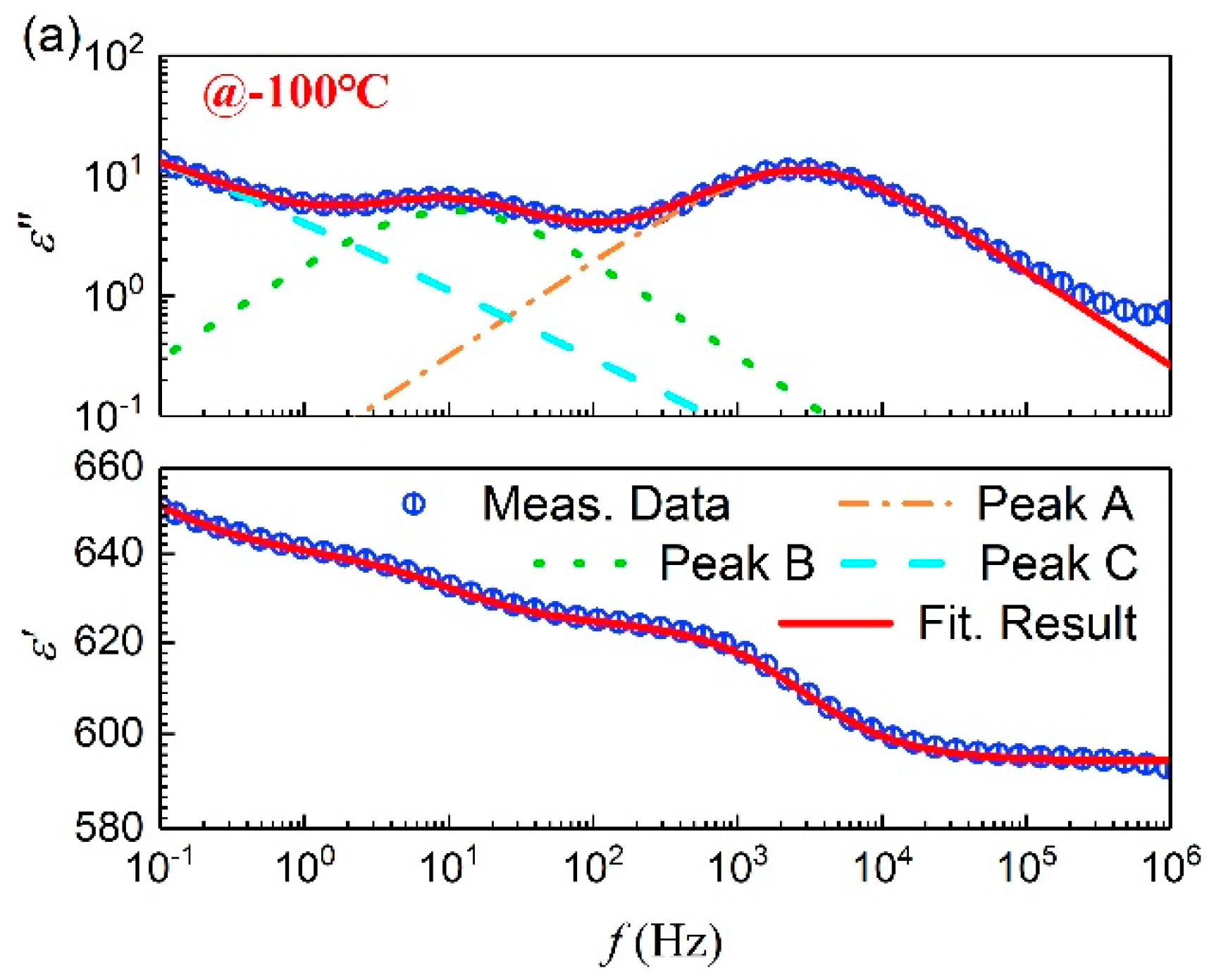
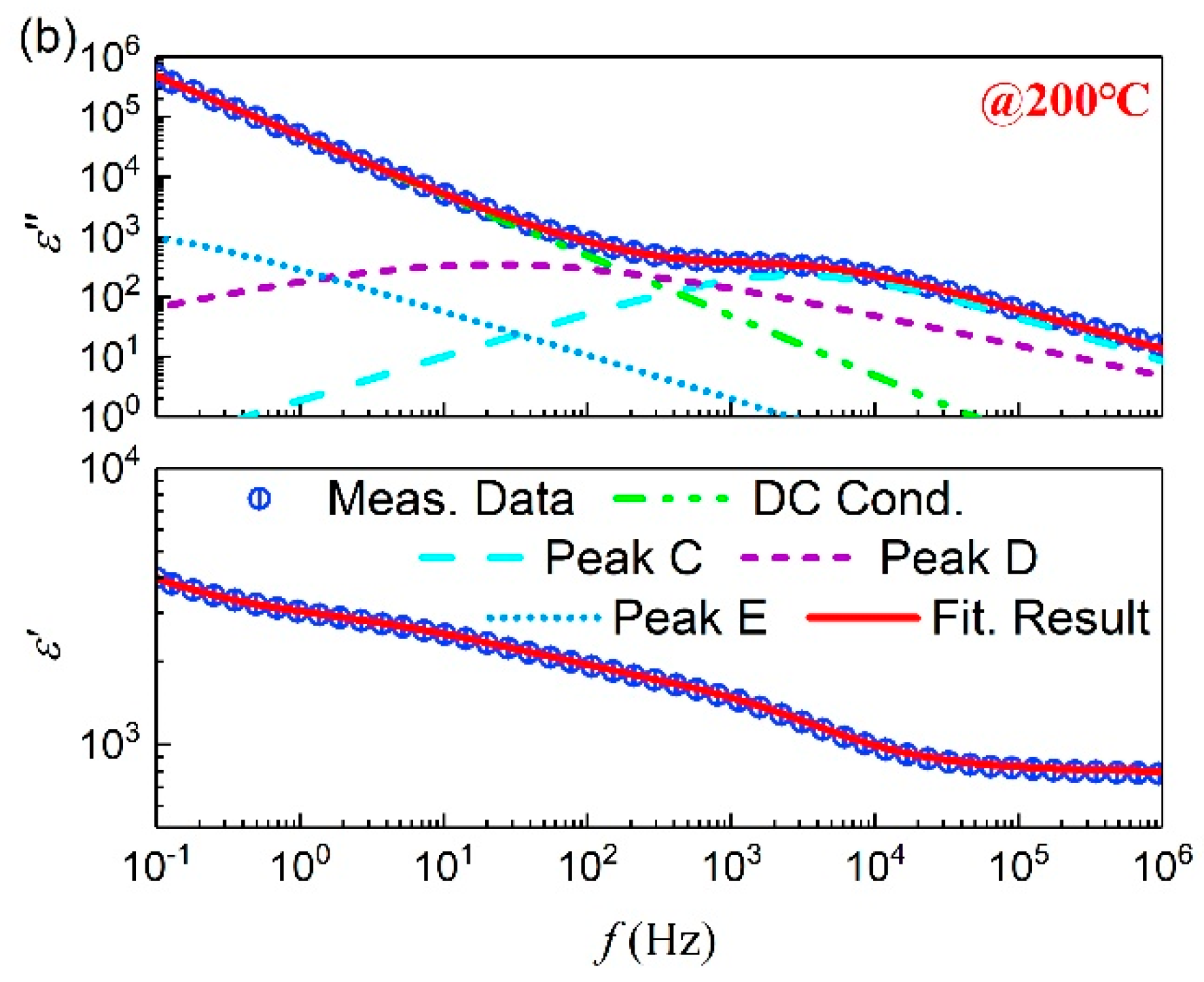




| No. | λ (μm) | D (gcm−3) | H (%) |
|---|---|---|---|
| S1 | 9.98 | 5.32 | 0.016 |
| S2 | 10.27 | 5.25 | 0.018 |
| S3 | 10.85 | 5.28 | 0.024 |
| S4 | 10.19 | 5.23 | 0.051 |
| S5 | 10.24 | 5.23 | 0.020 |
| S6 | 10.71 | 5.42 | 0.021 |
Publisher’s Note: MDPI stays neutral with regard to jurisdictional claims in published maps and institutional affiliations. |
© 2021 by the authors. Licensee MDPI, Basel, Switzerland. This article is an open access article distributed under the terms and conditions of the Creative Commons Attribution (CC BY) license (https://creativecommons.org/licenses/by/4.0/).
Share and Cite
Zhao, X.; Shen, H.; Guo, M.; He, Z.; Li, Y.; Wen, R. DC Aging Mechanism of Co2O3-Doped ZnO Varistors. Energies 2021, 14, 4011. https://doi.org/10.3390/en14134011
Zhao X, Shen H, Guo M, He Z, Li Y, Wen R. DC Aging Mechanism of Co2O3-Doped ZnO Varistors. Energies. 2021; 14(13):4011. https://doi.org/10.3390/en14134011
Chicago/Turabian StyleZhao, Xia, Haibin Shen, Men Guo, Ziming He, Yupeng Li, and Ran Wen. 2021. "DC Aging Mechanism of Co2O3-Doped ZnO Varistors" Energies 14, no. 13: 4011. https://doi.org/10.3390/en14134011






